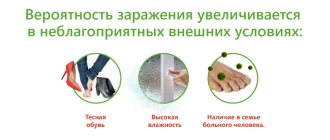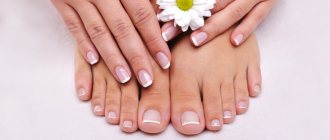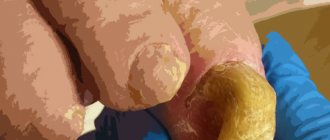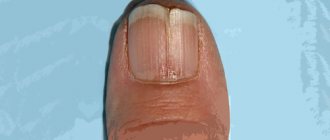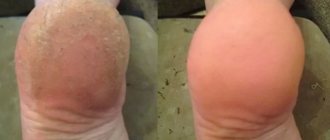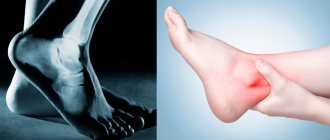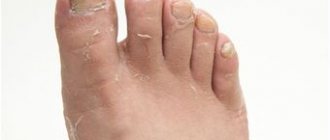Photo source kroshka__nastya/freepik
In medicine, there are a large number of extremely narrow specialties that are aimed at treating a specific group of diseases or organs, areas of the body. One example of such a narrow direction can be considered a podiatrist.
What does a podiatrist treat?
Podiatry is a medical branch that deals with the treatment of diabetic feet, rehabilitation procedures for feet after injury, and problems with ingrown toenails. Thus, we can say that a podiatrist is a doctor who treats feet and creates complexes for complete medical care for them, which is quite closely related to dermatology.
At the same time, the specialist’s responsibilities include performing nail removal operations. And ultimately relates to the surgical field.
Based on these data, we can conclude that podology is a science that combines the principles of dermatology and surgery.
Treatment of onychomycosis (nail fungus) in Moscow and Krasnogorsk
In the treatment of onychomycosis infection on the nails, cooperation in tandem between a podiatrist and a dermatologist is very important. If all recommendations are followed, the patient shows positive dynamics over time.
In Tatyana Pak's podological practice you can receive comprehensive professional assistance from podologists in solving problems of nails and feet:
- Specialists are annually promoted by their Western colleagues as podiatrists;
- The work uses modern techniques for painless treatment of nails affected by infection and solving other problems of nails and feet;
- New generation equipment;
- Strict accounting for disinfection and sterilization of instruments.
After each patient with onychomycosis, the room is processed:
- bactericidal lamp,
- wet cleaning of all surfaces,
- walls up to the ceiling and floors are treated with a disinfectant solution,
- Constant operation of supply and exhaust ventilation does not give a chance to inhale waste nail dust and settle on the surface and clothing of the patient.
“Pedicure Center” is a guarantee, comfort and safety of our patients! We can solve your problem even in the most advanced cases.
Our main task is to take care of your health!
Podologist and medical pedicurist
Photo source nensuria/freepik
Due to the fact that the most common reason for visiting a podiatrist is problems with toenails, ordinary people sometimes confuse concepts such as “cosmetological pedicure” and “medical pedicure”.
The fact is that a therapeutic pedicure is necessary not for aesthetic appeal, but in order to remove infection and pain. In other words, allow the foot to function normally. Pedicurists do not pursue such a goal. Moreover, they do not have the necessary skills and knowledge to do this. Therefore, if a conscientious master discovers a problem in the field of podiatry, he will not carry out the procedure, but will advise you to contact a medical specialist. And the podologist, in turn, will carry out medical procedures, after which the patient will receive a healthy nail plate. In addition, he has the necessary knowledge to perform operations to remove the nail plate or dead tissue.
And the easiest way to distinguish a doctor from a medical pedicurist is education. Thus, a podiatrist must have a higher education in dermatology or surgery, as well as appropriate additional training.
If necessary, he may be invited as a member of the medical council. For example, if a patient suffers from diabetes, a podiatrist is invited to avoid the possibility of developing diabetic foot or to select a course of treatment.
When to contact a podiatrist?
A consultation with a podologist will not hurt anyone, including even a child. He will teach parents how to properly care for and cut their baby’s nails. This is important, since correct foot care habits instilled from childhood are the key to the absence of problems in the future.
Teenagers will learn about hygiene rules, how to choose shoes, and what coatings are safe to use to decorate the nail plate on their feet.
For adults, a podiatrist does therapeutic and preventive pedicures and works with existing complaints. Everyone over 40 years old needs his consultation at least once a year. Especially for people who are overweight, women who wear shoes with narrow toes, high heels every day, as well as those whose professions involve intense stress on the lower extremities.
Older people need to visit a podiatrist regularly. The risks of diseases of the nails and skin of the feet increase with age, and it is better to identify them in the early stages. For example, nail fungus occurs in half of people over 60 years of age.
Reasons to contact a podiatrist include:
- core calluses, corns, cracks;
- increased blood glucose levels;
- excessive sweating of the feet;
- plantar warts;
- nail fungus;
- ingrown nail;
- frequent cramps in the foot area;
- pain, feeling of heat, cold, itching, burning in the feet;
- swelling of the legs;
- delamination, curvature, change in color of the nail plate;
- uneven wearing of shoes;
- foot deformity (bump on the big toe or little toe, flat feet, clubfoot, hammertoes, etc.).
Responsibilities of a podiatrist
Most often, patients who have already undergone diagnostics come to the podiatrist, and a dermatologist or surgeon has come to the conclusion that a specialized specialist can handle such a problem. At the same time, there are quite a lot of responsibilities for a podiatrist, these include:
- conducting a survey;
- referral for analysis;
- carrying out special procedures or operations;
- tracking the recovery process;
- work with medical documentation.
In order to perform the tasks assigned to a specialist, he needs to know:
- anatomy and physiology;
- dermatology;
- anesthesiology;
- principles of surgery;
- pharmaceuticals;
- endocrinology.
What to do with a deformed nail?
As a result of injuries, previous diseases or congenital characteristics of the body, the structure of the nail plate may change. Deformation causes pain and chronic discomfort. To treat a deformed nail, one session of medical pedicure is usually sufficient.
Symptoms:
- formation of depressions, bulges or cracks at the base on the nail plate;
- change in nail color;
- curvature of the nail;
- a sharp increase or decrease in the thickness of the nail plate.
The podologist will conduct an examination, make a diagnosis and eliminate the cause using a therapeutic or hardware method. In advanced situations, the doctor writes a referral to a surgeon.
Podologist's place of work
A qualified specialist can engage in private practice, as well as work in medical institutions - hospitals and clinics. In this case, it is necessary to pay attention to the fact that a private practice specialist must have an equipped room for performing surgical procedures. And in clinics, the doctor always has an assistant - a nurse.
In general, the working day of a doctor in this category is standardized. And cases with urgent patients are rare rather than a constant occurrence.
Treatment of ingrown toenails by a podiatrist
Ingrown toenails are one of the most popular foot pathologies. If several decades ago the problem was eliminated surgically, today it is possible to do without surgery. The podiatrist performs the correction by installing plates or staples, which lift the nail plate and prevent ingrowth into the tissue. This technology allows you to wear regular shoes during treatment and do everyday activities.
Correction of the nail plate can cope with serious nail deformations and prevent the recurrence of the problem. The correction period depends on the severity of the disease and ranges from several weeks to 2-3 months.
Where can I learn to be a podologist?
Today, a wide variety of centers and courses offer training to become a podiatrist. But it is important to understand that most often these courses are not suitable for medical professionals. And the use of the term “podology” is more of a marketing ploy.
In order to become a podiatrist, you need to obtain a medical education. The first step is admission to either the Faculty of General Medicine or Pediatrics. Next, the young doctor needs to enter residency. Most often, future podologists major in “Dermatology,” and after two years of training, medical specialists need to undergo postgraduate education in podology.
In general, to conduct a therapeutic pedicure, a specialist must have at least a secondary specialized medical education, as well as specialized courses. But such specialists do not have the proper qualifications for the entire extensive list of responsibilities of podiatrists, so they can work in aesthetic cosmetology organizations.
Removal of core calluses
Core calluses affect not only the superficial layers of the skin, but also damage the epidermis. It is not possible to cope with the situation with the help of folk remedies or popular creams for calluses of this type. Stop self-medicating and visit a medical pedicure office.
The main reasons for the formation of core calluses:
- defects in shoe insoles;
- mechanical damage to the foot;
- shoes made of synthetic materials;
- incorrectly selected shoe last;
- infection.
Shoes with flat soles or high heels often cause formations.
During treatment, a medical pedicure specialist uses several methods:
- cryodestruction – treatment of calluses with liquid nitrogen. Copes with calluses at all stages of formation. The session will take about 1 minute. Relapse is unlikely;
- laser destruction - the beam burns out the structure of the core callus to its entire depth;
- hardware removal - a milling cutter with abrasive attachments is used. The entire structure of the callus is cut out, the resulting cavity is treated with antiseptic agents to prevent inflammatory processes.
After treatment, the podiatrist prescribes care procedures - self-treatment of the skin of the feet with pumice stone or scrub, visiting a classic pedicure office for regular foot care.
It is important to eliminate the cause of callus formation - choose new comfortable shoes, taking into account the podiatrist’s recommendations. Shoes should not be tight, comfortable and made from natural materials. It is advisable to change the insoles.
What is hyperkeratosis and how to treat it?
An increase in the number of keratin cells leads to the formation of a stratum corneum. This disease is called hyperkeratosis and it can only be dealt with with the help of a podiatrist; therapeutic and hardware treatments are required.
Characteristic symptoms for hyperkeratosis:
- dryness and flaking of the skin of the feet;
- areas with thickened and rough skin;
- change in skin tone in areas with compactions;
- The pink color of the corns changes to a white or yellow tint.
If these symptoms occur, you should contact a medical pedicure office. The specialist will perform an examination, conduct visual diagnostics, and prescribe procedures.
Among the most effective procedures:
- treatment of the foot with softening compounds - keratolytics;
- removing a layer of keratinized cells using a scalpel;
- grinding of rough areas using cutters with attachments of different abrasiveness.
Specialized methods for treating affected areas include:
- laser exposure - an energy beam burns out the stratum corneum. The technique is effective, but leaves a small scar;
- liquid nitrogen treatment;
- removal of corns using an electric knife.
Modern methods give quick and predictable results.
Personal qualities of the profession of podologist
Photo source kroshka__nastya/freepik
Working with feet is very specific, so it is not suitable for everyone. To work you must have the following qualities:
- disdain;
- emotional resilience;
- excerpt;
- absence of fears and phobias associated with blood and dead tissue;
- good vision;
- developed hand motor skills;
- erudition;
- responsibility.
Diabetic foot: features of the syndrome
Diabetes mellitus is a serious disease that affects the quality of life. Diabetes also affects the foot; pathological changes occur in the tissues.
With diabetes, it is dangerous to have any wounds; they can become infected, and loss of sensitivity leads to the development of serious diseases. Symptoms of foot syndrome include thickening or thinning of the skin and the appearance of cracks. If you have diabetes, careful attention to the condition of your feet is required.
If an ingrown toenail appears, you should immediately contact a podiatrist, as even a small wound can cause major health problems. It is necessary to remember the increased risk of developing gangrene and not to self-medicate. Patients with diabetes should be monitored by an endocrinologist and regularly visit a podiatrist to receive quality care.
Features of reception and diagnostic methods
Like any appointment, a consultation with a podiatrist begins with a medical history and external examination. Next, based on the overall picture, the doctor decides to conduct certain types of diagnostics.
Depending on the clinical picture, the doctor may prescribe additional laboratory and hardware tests:
- examination of the skin using a Wood's lamp;
- general blood test using additional markers;
- general urine analysis;
- blood test for glucose;
- blood test for cholesterol;
- x-ray of the foot;
- CT or computed tomography;
- ultrasound diagnostics;
- taking biomaterial from the skin of the feet.
Based on the diagnostic results, the specialist assesses the scale of the disease and makes a decision on further referral of the patient to other doctors or independently carries out treatment according to his competence.
Treatment methods for flat feet
At the Alan Clinic Center for Neurology and Orthopedics, a number of modern, mild in their effects, but very effective methods are used to treat flat feet:
- Manual therapy
- Osteopathy is treatment done by a doctor, with a gentle effect on the musculoskeletal system, nervous and vascular systems, and internal organs.
- Medical massage
- Acupuncture - exposure to biologically active points with microneedles.
- Laser reflexology is a painless effect on reflexogenic zones and points.
- Tsubotherapy is a gentle effect on the reflex points of the body.
- Pharmacopuncture is the introduction of medicinal drugs of natural origin to the source of the problem.
- Plasma therapy is the introduction of the patient’s own purified blood into the site of the disease.
- Isometric kinesiotherapy - individual gymnastic techniques/exercises, according to indications, with elements of joint massage.
- Kinesiotherapy using the Exart installation
- Kinesio taping
- Ozone therapy is treatment with active oxygen.
- Physiotherapy
- Physiotherapy with enzyme preparations
- Shock wave therapy
- Medical droppers
- Hirudotherapy - treatment with leeches.
- Botulinum therapy is treatment with botulinum toxin.
- Intra-articular injection of synovial fluid endoprostheses
- Intra-articular blockades
Pros and cons of the profession
pros
- To obtain a specialized education, it is enough to complete a course in manicure and pedicure, and then a course in medical hardware pedicure.
- Podiatrists are in demand, because a large number of people suffer from foot problems.
- Podologists work in salons, most often having a separate office, necessary equipment and consumables. Working conditions can be called quite comfortable.
- Decent level of remuneration; specialists often receive tips from clients.
- In the future, you can open your own office.
Why is it important not to put off visiting the doctor?
The feet are a kind of indicator of human health; many manifestations on this part of the body can be used to judge the condition of the whole organism and the presence of various pathologies. At the same time, early diagnosis of diseases is extremely important for curing patients and preventing all kinds of complications.
It would seem like a simple pain in the toes or heel, but it can cause general lameness and disorders of the musculoskeletal system, and if you start pathologies associated with the vascular system, you can lead the body to gangrene, the treatment of which will require radical surgical measures.
Regulations
1. SanPiN 2.1.2.2631-10 “Sanitary and epidemiological requirements for the location, design, equipment, maintenance and operating hours of public utility organizations providing hairdressing and cosmetic services Cashmere” Service: hardware pedicure
Offer:
- regular maintenance (care) for problematic legs, hands, nails of clients and joint management of the patient with the doctor;
- a monetary percentage to a specialist from the number of clients sent to the Center for servicing (based on the fact that real clients come to the Center, and not based on the number of referrals issued);
free service for a circle of people (i.e. direct participants in contractual relationships and their close 2-3 people);
- placement in the public area of the medical facility (corridor, cloakroom, reception area or other place) of a stand with the Center’s booklets.
Courses
Institute of Podology
The institute has a large number of programs that will allow you to study the intricacies of medical hardware pedicure. Most programs are aimed at specialists who want to improve their skills and gain new knowledge.
School of Podology "MiradaMed"
The school offers basic courses, advanced training programs, and individual programs. Students are trained by specialists with many years of experience; distance learning is possible.
School of hardware pedicure “Podolog”
The school offers a wide range of training programs that will help you learn how to perform regular manicures and pedicures, as well as medical equipment. The programs are aimed at people who do not have knowledge in this area. Under the auspices of the school, master classes can be organized, as well as on-site or individual training.
Symptoms of flat feet
- Pain in the feet.
- Worn shoes on the inside.
- Fatigue quickly when walking.
- Fatigue and pain in the legs at rest and when moving.
- Swelling and cramps in the legs.
- Lower back pain.
- Knee pain.
- Pain in the hips.
- Headache.
If you notice any of the above symptoms, be sure to get tested.
What is the difference from a regular pedicure?
Firstly, for the purposes: in a regular pedicure the main thing is aesthetics, in a medical pedicure it is to solve the problems of the skin of the feet and nails.
Secondly, in the tools. Salon (aesthetic) pedicurists usually use files, scissors, varnishes (gel polishes) and extension materials. A specialist in the field of podiatry will need dozens of a wide variety of tools for special treatments, including tools for orthonyxia (ingrown toenail): staples, burs, cutters, double-sided probes, files, rasp for ingrown toenails, loops, forceps, nippers. As well as a variety of materials for prosthetics, the manufacture of orthoses that correct the foot, taping, wound treatment, and foot unloading. The podiatrist's place of work should resemble a doctor's (sterile) office, and not a leather chair with soft cushions in a beauty salon.
